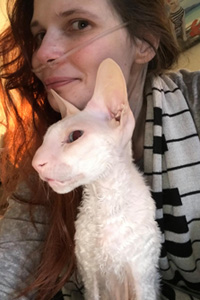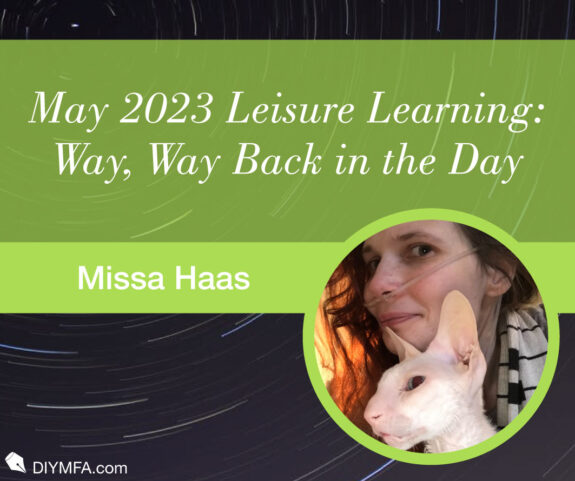Greetings and felicitations, fellow nerds of the word! The May 2023 Leisure Learning column focuses on literary contributions somehow related to the past. Gain insight into William Blake’s process for resurrecting the illuminated manuscript, meet some lesser-known family members chronically overshadowed by their famous relations, and see how Walt Disney’s soldiering days influenced early Disney films.
Finally, if you grew up writing when paper was all the rage (or the only thing available) and struggle with the technological nature of contemporary life, have a laugh at what it must’ve been like when we switched from scrolls to books via The Helpeth Desk.
May 2023 Leisure Learning Picks
Disney Rocks the Rococo
A while back, the Metropolitan Museum of Art held an exhibit showcasing Walt Disney’s inspiration from the French Rococo period. This overview of the exhibit demonstrates how Disney translated not just the style but the ideas found flowing within the French decorative arts into some of the works that are now part of our cinematic canon (i.e., Beauty and the Beast, Sleeping Beauty and Cinderella).
This is worth showing younger children to help them understand how real life objects can inspire different forms of art and introduces just about everyone to the overlooked woman behind Cinderella’s concept art. While the exhibit video constitutes my family pick for the month, these elegant, erudite 26 minutes are best to take in with the adolescent artist in your life or simply to enjoy on your own with a nice cup of tea.
**Close ups of pieces mentioned in the video are available here.
Hernando Colón: Son of Columbus & Creator of Bookshelves
Hernando Colón (aka Ferdinand Columbus) is best known for being Christopher Columbus’s second illegitimate son as well as a dutiful biographer. However, he is rarely credited with what he considered his life’s work: creating the first European library.
Although he was illegitimate, Hernando was acknowledged and given everything a son could be given. Notably, he grew up in a number of different homes, always having access to aristocratic and even royal tutors. Early on, it was clear that, while his father was an explorer of the world, Hernando was an explorer of the mind.
As such, Hernando passionately attempted to incorporate all that he had learned with all that was being discovered. Europe’s first library held three times as many books as the largest private book collection at the time. Still, one of his overarching contributions often gets lost in his own narrative, and that is his innovative implementation of how to access this knowledge.
Hernando sought to put all of the world in order. After assembling numerous volumes of books, pamphlets, and anything else that could essentially be read, he paid an army of readers to write synopses and then log the various holdings.
In The Catalog of Shipwrecked Books, biographer Edward Wilson-Lee explains that prior to Hernando, bookshelves weren’t a thing. People walked into Hernando’s library and were astounded by not only the books but bookshelves! Prior to this, retrieving a tome from a tall stack was like playing an involuntary game of Jenga. His father might’ve found the New World, but Hernando made a new world. We owe the vertical placing of books to this guy.
If you’d like to see the floor plans and other visuals, this lecture by Wilson-Lee offers the best images available.
Normally, this would be the end of the write-up for Hernando Colón, godfather of the library (we can’t overlook the original in Alexandria). Yet, shortly after The Catalog of Shipwrecked Books was published, Hernando came into prominence again. In the spring of 2019, the codex containing his library holdings (El Libro de los Epítomes) resurfaced when accidentally purchased along with a collection of antiquarian Icelandic manuscripts. See a pic of the nearly foot-high volume and get up to speed with this NPR segment.
Letters Live
Letters Live is a UK based organization that revives the art of written correspondence. Very much in the tradition of Mortified or The Moth, Letters Live has actors read letters that people have actually written or received. Their twist on it provides us with extremely well-dramatized, often humorous performances of something that has been largely lost in the age of texts and email.
Benedict Cumberbatch, Tom Hiddleston, Olivia Coleman, and Ian McKellan are just some of the actors who infuse written letters with new lives. The curated collection of readings runs the gamut from personal correspondence to legendary letters written to departments, companies, and institutions.
Here, Keegan Michael Key reads a response from The Smithsonian to the man who kept sending them “artifacts” from his backyard. Taika Waititi gives dramatic justice to an Auckland man replying to an inquiry from the Wellington Police Department. Re-live what a WWI captain wrote to his wife just as opposing forces called a truce on Christmas Eve.
If you are having a blah day, this is the perfect way to awaken your soul. Most YouTube clips are under five minutes and guaranteed to be emotionally gripping. Should you care to make an entire night of letters read live, entire performances of the show are available for free.
Medieval Words Worth Reviving
Remember when you were a kid and simply saying “shenanigans” or “bamboozle” occupied a terrific few seconds of time? Just between you and me, words can be fun. I still regard saying silly things such as flibbertigibbet as a simple but great joy in life.
BBC newscaster Rob Watts feels the same. He is fascinated by words, and in this clip has done fellow linguaphiles the service of selecting top words from medieval English worth slipping into a conversation, manuscript or epic-ly controversial game of Scrabble.
Find out when “mango” didn’t refer to a fruit, consider adding “russin” into your routine, or wryly name a parrot “Papa Jay” after listening to this “Best of” 13th century Anglo-English ever recorded.
Viewers should note that Watts’s list was compiled from an original contribution made by die hard word nerd, Herbert Coleridge who, at age 17, cataloged all of the known words from medieval England (specifically, 1250-1300 AD).
BTW, if you were wondering, this does happen to be the grandson of the famed poet Samuel Taylor Coleridge. Love of English run in the family much?
William Blake, Mixed Media Artist
William Blake is the Romantic poet best known for The Tyger, his idiosyncratic revival of the illuminated manuscript form, and that one time he and his wife got caught reading Paradise Lost in the nude.
Well, maybe not so much that last one.
During his lifetime, Blake worked as an engraver while also practicing poetry and painting. His mind dwelled in the realm of the fantastic, favoring Heaven and Hell. Even today, his personal style is considered captivating and it is worth mentioning that Silence of the Lambs author Thomas Harris drew upon Blake’s Great Red Dragon paintings for his own book, Red Dragon.
These days, Blake might be considered a mixed media artist. This video contextualizes what that meant in the 18th century and how Blake achieved his still stunning effects.

Melissa Haas is the author and illustrator of Catula: The Misadventures of Dracula’s Cat and The Night Before Christmas (NOW WITH CATS), among others. Follow Catula’s whereabouts on Instagram @CatulaTheCat. If you’re interested in downloading free coloring pages or seeing Margaret Atwood with a blowtorch, check out more Leisure Learning related content at www.MelissaHaasCreates.com.







